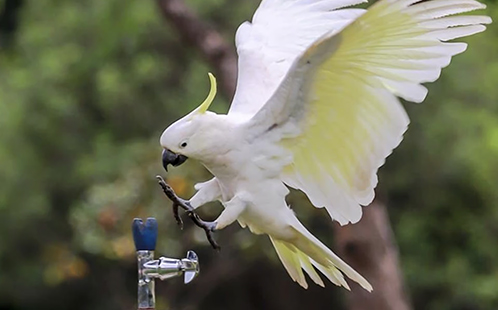 Coming in to land: A cockatoo heads to the park drinking fountain - Photo credit: Klump et al, Biology Letters
Coming in to land: A cockatoo heads to the park drinking fountain - Photo credit: Klump et al, Biology Letters
They have previously been caught hot-footed prying opening wheelie bins to forage for food. Now Sydney's crafty cockies have been spotted cooling off – by learning how to turn the handles on public drinking fountains.
New research by Max Planck Institute, University of Vienna, Western Sydney University and Australian National University published in the international journal, Biology Letters, has tracked populations of sulfur-crested cockatoos in Western Sydney and filmed their behaviour as they learned to turn the handles on water fountains and help themselves to a drink.
The research team, which included Dr John Martin who is an honorary researcher at the University's Hawkesbury Institute for the Environment, filmed the cockatoos in action using motion-triggered wildlife cameras.
Across a number of local reserves and sports fields in the Western Sydney area, the cockatoos were observed over a number of weeks successfully starting the fountain's water flow and obtaining a gulp of water 41 per cent of the time.
These findings follow the team's previous research which observed populations of sulfur-crested cockatoos learning bin-opening behaviour across greater Sydney so they could forage for food waste.
Dr Martin described the ingenious tactics the birds utilised to help themselves to the water.
"We watched the cockatoos operating the drinking fountain using coordinated actions with both feet. More often than not, the bird would place one foot – mainly the right –on the twist-handle or the valve, with the other foot used to gripping the rubber spout or bubbler. Sometimes they would also use both feet on the valve," explained Dr Martin.
"The weight of the bird would then be lowered to turn the twist-handle clockwise and keep it from springing back. We would observe the bird then turning its head to access the flowing water."
He said the behaviour appears to be widely adopted in the local cockatoo population, suggesting it is spread through social learning, much like the bin-opening behaviour.
Dr Martin said most of the visits to the drinking fountains were during dawn and dusk time, in line with the scientists' expectations for when the birds would likely use the fountains as a water resource. Often there was a queue of birds perched on a nearby fence, waiting their turn.
Unlike the bin-opening habits which heavily-favoured male birds, the researchers this time found little difference between male and female cockatoos when it came to their drinking fountain behaviour.

Dr Martin said the findings show that wild cockatoos are highly successful at adapting their behaviours to the challenges and opportunities that come from living in big cities and urban areas.
"The research shows that despite challenges like loss of habitat, cockatoos are very successful urban adaptors," said Dr Martin.
"It's the first time we are aware of wild parrots developing this kind of innovative drinking behaviour.
"We know that cockatoos have a particularly high level of innovativeness and problem-solving, and are attracted to novelty.
"It shows that this kind of drinking innovation can be learned and then spread amongst a local bird population, forming a new urban-adapted tradition."






